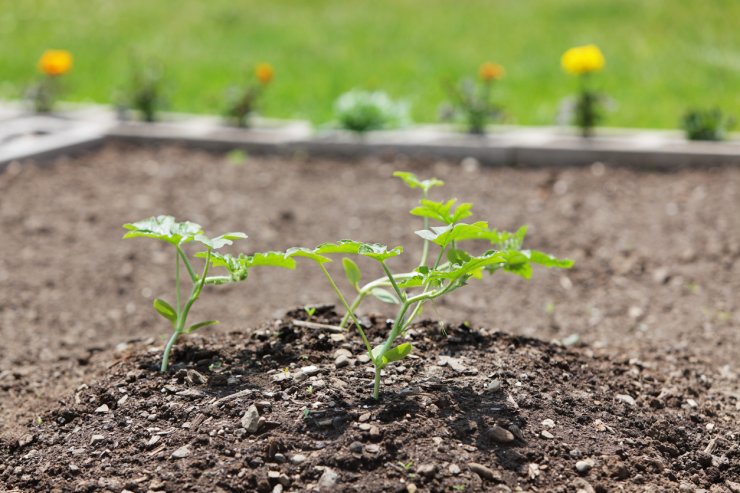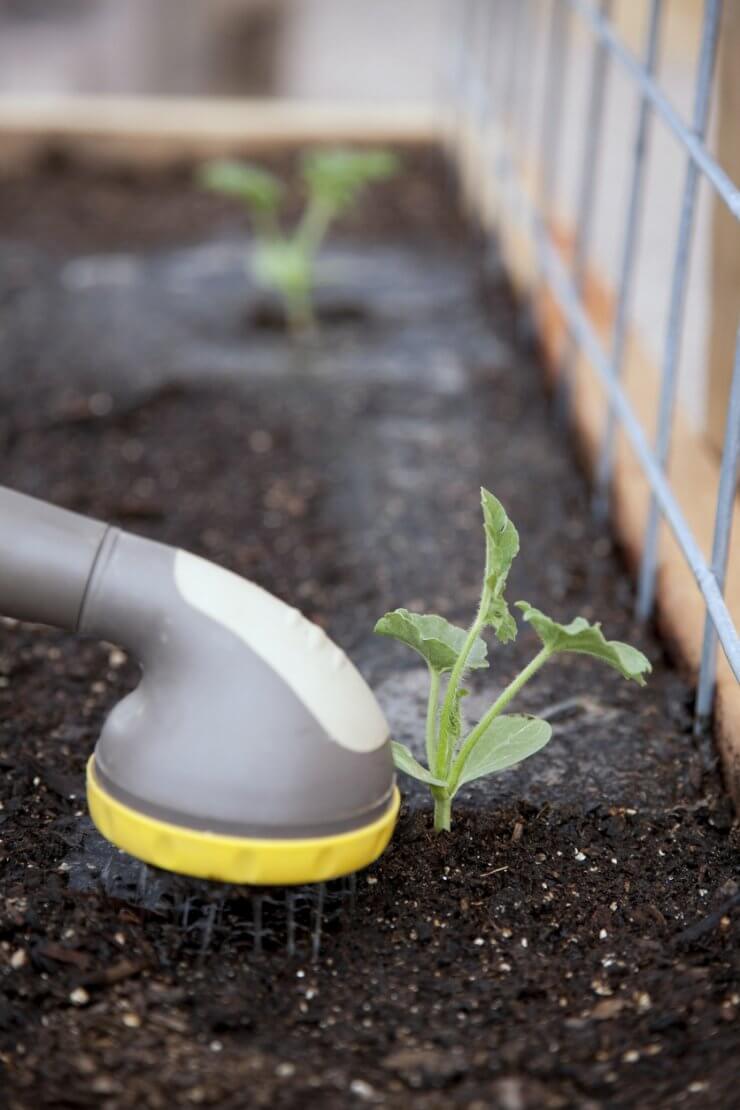
Watermelon seedling growing in garden bed
Planting Seeds and Seedlings
Because of their need for heat, don’t plant your watermelon plants or seeds until about two weeks after all danger of frost has passed. Watermelon requires air and soil temperatures above 70 degrees—preferably 80 degrees—to thrive.
If you’re worried about soil temperatures in your area, lay down black plastic sheeting or trash bags on the bed about two weeks before planting. The sun’s warmth will be reflected into the soil to raise the temperature.
Plant your watermelons in loose, well-drained, but moisture-retentive soil that is rich in organic matter. When you’re ready to plant, be sure to choose a spot that gets eight to twelve hours of sun per day. The more sunlight the watermelon plant gets, the better your yield will be.
To plant either seeds or seedlings, first dig a hole about 1 foot in diameter and 1 foot deep. If you’re planting more than one watermelon, be sure to space your holes apart to accommodate the variety you’ve chosen—anywhere from 3 feet all around to 10 feet around.
Fill the hole completely with garden soil, compost, and a handful or two of sand to make sure the soil drains well. The most important part is adding fertilizer. Start with a nitrogen-based fertilizer to give your plant the nutrients it needs right from the beginning. (Later, you’ll switch to a different fertilizer.) Mix the fertilizer into the soil well to avoid burning the plant’s roots.

Watermelon sprouting in planting mound
Once you’ve filled the hole, use the remaining soil you dug out of the ground to build a small mound at least 6 inches tall, and flatten the mound at the top. This is where you plant a couple of seeds (1/2-inch-deep), or one seedling. If you plant two seeds, you’ll thin out the weaker of the plants later, but this gives you a better shot at having at least one good grower.
Don’t grow watermelons where cucumbers or squash have been grown recently.
Do plant watermelons near bush beans, corn, dill, eggplant, lettuce, and tomatoes.
Watering and Fertilizing your Watermelon Plants

Hand-watering a watermelon plant at the base
Unsurprisingly, watermelon plants require a good supply of water. Always water deeply at the base of the plant on a regular schedule. Your watering schedule will depend, of course, on how much rain you get. As a general rule, water your watermelon plants whenever the top 2 to 4 inches of soil is dry, and never let the watermelon vine get dried out.
- Another tip: Leaf wilt at the end of the day is no cause for concern. But if the leaves are wilting in the morning, water your plants immediately.
If possible, a drip irrigation system is the best option for ensuring slow, deep watering, but don’t worry if you don’t have one. Home growers have been successfully harvesting fat watermelons for years, and you can, too! Be sure to mulch around your plants to keep moisture in and weeds out.
In any case, stop watering about a week before harvest. This allows the sugars to concentrate in the fruit and gives you the sweetest possible flavor.
Fertilize weekly with a nitrogen-based fertilizer until the plant’s flowers blossom. After that, use a phosphorus-based fertilizer, again applied on a weekly basis. Watermelons love their nutrients, but too much nitrogen will encourage leaf and vine growth, not fruit.
Have you ever had problems fertilizing or watering your watermelon plants? Please tell us your secrets for getting a good watermelon crop from your garden.


 Previous
Previous

